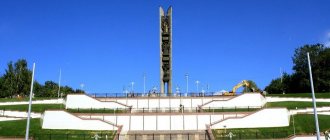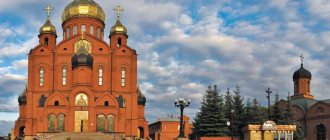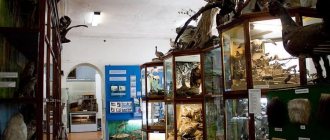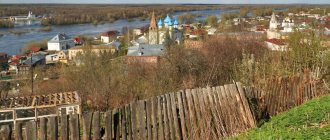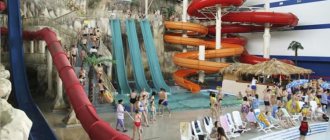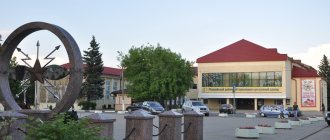Penza is located in the Middle Volga region, east of Moscow. Three rivers flow within the city: the Sura, as well as the Penza and Moika rivers, which flow into the Sura. The historical center of Penza is located on the Sura River, in the central part of the city.
Penza is the administrative, economic and cultural center of the Penza region. Here are unique historical, cultural and architectural monuments that attract tourists from Russia and foreign countries.
What to see
Pre-revolutionary buildings have been preserved in the city center. Here you can see the remains of a defensive rampart and a partially restored fortress palisade. In place of the corner tower of the fortress, a symbolic wooden belfry with a cast-iron mortar was installed.
On the observation deck there is a monument to the Migrant, erected in honor of the founder of the city and its first inhabitants.
The settler holds a spear in one hand and leans on the plow with the other. The bronze composition reflects two beginnings in the life of the first inhabitants of the city - peasant labor and the defense of the fortress from the raids of nomads.
One of the favorite vacation spots for city residents is the Penza River Embankment; this ancient street was known back in 1819. The Rostock monument is installed here, which is a symbol of the city, to which newlyweds traditionally come on their wedding day.
It is interesting that until 1945 the Penza River flowed into the Sura beyond the Bakuninsky Bridge. Later, the Sura changed its course and began to flow along the bed of the Penza River. Therefore, currently the street named Embankment of the Penza River is the embankment of the Sura River.
On holidays, you can admire colorful fireworks here. A 292-meter-long suspended pedestrian bridge spans the Sura.
Within the city limits there is a picturesque protected forest park “Zaseka”, and on the banks of the Sura there is the Akhuny resort, famous for its healing springs of mineral waters and peat mud.
About 400 monuments of history and archaeology, architecture and art are located in the Penza region, 47 of them are of federal significance.
Monuments of the Penza region
The First Settler monument is a symbol of the city; it was opened to the public on September 8, 1980, as a memory of the 600th anniversary of the Battle of Kulikovo. The talented sculptor Valentin Grigorievich Kozenyuk and architect Yu. V. Komarov worked on its creation. The monument rises in the historical district of the city, in close proximity to the remains of the Penza defensive rampart of the seventeenth century. This monument with a telling name reflects the fate of the first inhabitants of the Penza lands. The monument represents a man and his horse. The man holds a spear with one hand and touches the plow with the other, this tells us that two principles live in him - a warrior and a peasant.
Penza was and is still famous for its talented people. The famous jeweler Vladimir Lomonosov worked diligently throughout his life and did not think about a monument in his honor. Thanks to his grandson Maxim, the Penza jeweler had a bronze monument erected. The grand opening took place on the day the city was founded - June 12, 2013. It was attended by the regional governor and the chief architect of Penza. The monument was cast in bronze by famous local sculptors: G. Feoktistov and V. Kuznetsov.
The monument to Denis Vasilievich Davydov was erected in Penza 30 years ago, in 1984. The inspiration for the creation of the monument was the Soviet party leader, secretary of the Penza Regional Committee of the CPSU Georg Vasilievich Myasnikov. The sculptor was local painter and sculptor Vladimir Georgievich Kurdov, Honored Artist of Russia. It was decided in honor of the celebration of the 200th anniversary of the birth of Davydov D.V. to perpetuate his memory with a bronze monument in the form of a bust. It was decided to make the pedestal from granite, the shape is tetrahedral.
The monument to the outstanding literary critic and philosopher Vissarion Grigorievich Belinsky in Penza was erected at the beginning of the 20th century, but had a sad demise - it was demolished during the uprising of the Czechoslovak Corps in 1918. The second attempt to install the monument occurred in the mid-20th century. (1948), when the Soviet architect L.M. Polyakov took up the work. and sculptor-monumentalist Vuchetich E.V. They worked on the sculpture for 6 long years. The honor of casting the bronze monument (they decided to make it full-length, with the right arm outstretched) fell to the St. Petersburg art casting plant “Monumentsculpture” in 1954.
Temples and monasteries
There are more than 50 temples and monasteries in the city.
Transfiguration Monastery
In 1689, a monastery was founded in the center of the city, next to which the Church of the Transfiguration was erected. In 1794, the monastery was moved to the outskirts of the city, where monastery churches were built. After the revolution, all the buildings of the new monastery were destroyed and the monastery was closed.
In 2001, a monastery courtyard was opened on the territory of the old monastery; since 2010, it has been transformed into a monastery; now it is a functioning monastery. The Transfiguration Church is the oldest stone building in the city.
Trinity Convent
In 1692, the Trinity Convent was built on the outskirts of the city. Initially, all its buildings were wooden, and in the middle of the 18th century the construction of stone buildings of the monastery began. In 1918, the monastery was closed, its restoration began in 1992 on part of the old territory. Currently, it is a functioning monastery, where the following temples have been preserved:
- Cathedral of the Life-Giving Trinity, founded in 1702
- Church of the Descent of the Holy Spirit, founded in 1854.
In Penza there are churches of the 17th–19th centuries, including:
- Cathedral of the Intercession of the Blessed Virgin Mary - 3rd quarter of the 17th century
- Cathedral of the Assumption of the Blessed Virgin Mary, founded in 1836
- Church of the Icon of the Mother of God of All Who Sorrow, Joy of All Who Sorrow, at the women's diocesan school in Penza, 1880.
City `s history
In 1663, Tsar Alexei Mikhailovich, by his decree, ordered governor Yuri Ermolaevich Kotransky to build a wooden Kremlin to protect the Moscow state from raids by nomads. By order of the Tsar, Voivode Kotransky, together with a hundred Circassian Cossacks, arrived on the Penza River and built a fortified city here.
Five years after the construction of the fortress, the steppe inhabitants attacked the city, but they failed to conquer it.
The history of Penza is also connected with the Peasant War led by Stepan Razin. In September 1670, his army approached the walls of the fortress, and despite the entreaties of the city governor not to let the rebels in, on October 9 the fortress gates were opened and Stepan Razin’s soldiers under the command of Ataman Mikhail Kharitonov entered the Kremlin. However, already in December 1670, the time of reckoning came for the rebels and they were all punished.
In subsequent years, nomads tried to take the Kremlin several times, and the largest raid of the Crimean Tatars and Nogais, known as the Great Kuban Pogrom, was carried out in 1717 and this was the last attack on the fortress.
According to legend, underground passages were also built at the same time as the fortress, as evidenced by the records of the fortress preserved in the Armory Chamber: “eight towers, including two roadways and two hiding places with wells” (underground passages were called hiding places at that time).
In the 60s of the last century, during excavation work, an excavator bucket touched the log flooring, under which there was a dungeon. According to the stories of local residents, the underground passage had two directions: to the Trinity Convent and to Sovetskaya Square (previously it was Cathedral Square).
During fires that destroyed wooden buildings, the priests sheltered the townspeople underground.
In 1774, during the Peasant War, the army of Emelyan Pugachev entered the city. It did not stay here because it was pursued by the sovereign’s army. The people hoped to gain freedom, achieve a better life and warmly welcomed the rebels. But in the two days that the rebels were here, the Crystal Factory was destroyed, thousands of nobles were hanged, and chaos was created everywhere. However, the impostor was soon caught, and the rebels were severely punished.
There is a legend according to which in August 1774, on the orders of Emelyan Pugachev, in the longest underground tunnel dug from the city center under the Sura River to the island of Sands and further to Akhun, the rebels hid a thousand pounds of silver. At the same time, historians deny this legend, believing that the retreating army needed money and there was no point in hiding it underground.
The fortress that was built has not survived to this day - its remains were demolished in 1839.
The 19th century passed peacefully and calmly for Penza. The names of such famous nobles as the Arsenyevs and Sheremetevs, the Shuvalovs and Golitsyns, the Kurakins and Dolgorukies, the Suvorovs and Vorontsovs were associated with the history of the provincial city. Alexander Radishchev and Mikhail Lermontov, Denis Davydov and the poet Vasily Zhukovsky were here. Many famous people of that time studied in the city: Vissarion Belinsky and Lenin’s father Ilya Ulyanov, surgeon Nikolai Burdenko and writers Mikhail Saltykov-Shchedrin and Nikolai Leskov.
In 1793, one of the oldest theaters in the country was opened in the city, and in 1874, the first national stationary circus of the Nikitin brothers in Russia was opened.
In the 18th century, Penza was part of the Kazan, and later - the Penez and Saratov provinces, and in 1801 the Penza province was again restored, which included part of the territory of the modern Republic of Mordovia with its current capital.
The construction of the Syzran-Vyazemskaya railway and the highway to Ruzaevka was of great importance for the city. These railway lines contributed to the development of industry and trade for the entire Penza region. At the fair in Penza, local merchants traded bread, wine and cloth; traders from many Russian cities came here.
During the Civil War, battles were fought with the White Czechs on the territory of the city. In 1928, the country's first Civil Aviation School opened in Penza, seven of whose graduates became Heroes of the Soviet Union, including the legendary pilot Valentina Grizodubova.
In 1937, Penza became the main city of the Penza region.
During the Great Patriotic War, enterprises from Ukraine, Orel and Voronezh were evacuated to the city, and mortar weapons were produced at Penza factories.
Currently, the city is known as a center of mechanical engineering and a major transport hub; the furniture, pulp and paper and food industries are also developed here.
There are sanatoriums and tourist centers in the region, located in picturesque places with beautiful landscapes. Penza has a convenient geographical and transport location, which allows it to attract both foreign and Russian tourists.
“Monuments of history and culture of the Penza region”
PENZA REGION
PENZA
The Penza region is located in the center of the European part of Russia, at the junction of three natural zones: forest, steppe and forest-steppe.
This is the land that has given the world so many extraordinary personalities.
The Penza land is proud of the writers V.G. Belinsky, M.Yu. Lermontov, D.V. Davydov, A.I. Kuprin, composer A.A. Arkhangelsky, directed by V. Meyerhold.
The famous silent film actor I. I. Mozzhukhin was born and raised in the city.
Penza land is the birthplace of the great historian V. O. Klyuchevsky, author of the “Course of Russian History”.
Penza began as a defensive fortress, built to protect the borders of the Moscow principality. At the beginning of the 19th century it was already a large city, the center of the province.
The city is the birthplace of the Russian circus. In 1873, a performance took place presented by Russian entrepreneurs - the Nikitin brothers.
Modern Penza has not broken away from its past.
The city has preserved merchant districts. Even the fact that Penza bears the title of the greenest city in the Volga region has historical reasons.
It all began with a visit to the city by Emperor Alexander II, who, having examined the memorial sites and discovered ruins and desolation on the site of the fortress, was very dissatisfied and proposed to create a park.
Today this is Lermontovsky Square, it begins the central street of Penza - Moskovskaya, Penza Arbat.
MONUMENT TO THE FIRST SETTLER.
"ROSTOCK"
It was unusual for 1980 to unveil a monument not to a politician or a major military leader, but to the First Settler - the one who defended his native land and developed it in peacetime. The sculptural composition is dedicated to the 600th anniversary of the Battle of Kulikovo.
On the Sura embankment there is a 25-meter-high monument to Glory, popularly known as “Rostock”. It symbolizes the development of the city and the country. Nearby is the Druzhba suspension bridge - the best engineering structure of the Soviet era.
TRAFFIC LIGHT TREE
"MUG OF BEER"
Traffic light tree.
There is a traffic light tree in the park opposite the train station. This art object consists of 36 old traffic lights that have spent their time on the city streets. As darkness falls, the traffic lights turn on and change colors to the beat of the music. The idea for this installation belongs to the former mayor of the city, Roman Chernov, who saw a similar tree in London.
"Mug of beer".
Moskovskaya Street leads to Fontannaya Square, notable for its light-and-music fountain and a reproduction of Manet’s painting “A Mug of Beer.” This impressive mosaic was made from 55 thousand beer caps and installed in 2000.
CLOCK “CUCKOO”
MUSEUM OF ONE PICTURE
"Cuckoo".
Near Fontannaya Square, in a small park, there is a tower cuckoo clock, as a monument to the wall clocks common in houses of the last century. This public garden in the city is a place for friendly meetings and romantic dates.
Museum of one painting named after G. V. Myasnikov
. The museum building itself is a 19th-century monument, the former home of a police chief. The museum does not have permanent large exhibitions. One painting at a time is exhibited there. Its screening is preceded by a film or story about the author of the work. There are no such museums in our country anymore.
M
ENTERPRISE
OF STAGE ARTS NAMED AFTER V.E.
MEYERHOLD M
FOLK ARTS HOUSE
Museum of Performing Arts named after V.E. Meyerhold.
The museum was opened in 1984 and became the first memorial monument to Meyerhold in Russia and abroad. The Meyerhold family lived in the building until 1898. The museum is also interesting because of the existence of the dramatic “Theatre of Doctor Dapertutto”. Performances are performed in a small hall, a former living room. The artists are a meter away from the audience. All eight theater actors are men. They play female roles and act as stage workers. All theatrical productions develop Meyerhold's ideas.
Museum of Folk Art.
The museum is located in the estate of the Penza timber merchant S.L. Tyurin. The estate is a real carved mansion, which contains objects of folk art: carved wooden vases, straw dolls, products made of wicker, Abashevo whistles.
M
UZEY V. O. KLUCHEVSKY
MEAT PASSAGE
M
V. O. Klyuchevsky’s house
. Opened in 1991. Consists of two wooden houses. The museum's exhibitions tell about the Penza period of the historian's life and about his scientific and social activities.
Meat passage
- architectural monument. It is already over 100 years old. At first there were shopping arcades there, then they wanted to turn the passage into an art gallery, but the dampness of the basements let them down. Now there are sports clubs there.
TO
UZNETSK
N
IKOLSK
Ascension Cathedral
. The wooden church was built in 1699. The cathedral became a stone one in 1856. With the help of believers, after the Soviet decline, the temple was revived. Today, divine services are held here, there is a Sunday school, classes in icon painting, and Orthodox books are stored.
Church of the Kazan Icon of the Mother of God
. It is notable for the fact that during Soviet times it was not destroyed and was not even closed. Built in the “Russian” style. The temple is interesting with its bell tower in the form of a three-tiered tent.
Chapel of St. Paraskeva the Martyr
. It stands on the site of the believers’ vision of the icon of the holy martyr Paraskeva. Local merchants provided funds for the construction of the chapel. Now there is an equipped approach to the source, you can get holy water and take a dip in the bath.
It is worth mentioning one more attraction of Kuznetsk. In the park near the city administration there is a taganaite stone brought from the Urals. The townspeople call it the stone of sun and love.
The city was previously called Nikolo-Pestrovka. In the mid-18th century, the village was merged with the settlement of Malaya Pestrovka. This is how a new city was formed. The crystal factory brought Nikolsk worldwide fame.
Museum of Glass and Crystal
. The collection was founded in 1789. Recognized by art critics as the best collection of glass in Russia. The collection began as a model room at the Nikolsko-Bakhmetevsky plant. Three generations of the Bakhmetev family collected samples created by the craftsmen of their factory, products of Bohemian and French craftsmen. During Soviet times. The collection continued to be replenished through the efforts of the plant’s directors, and now thanks to private individuals.
Kazan Church
. Built in the Byzantine style, it has an unusual wooden bell tower.
Museum of the writer A. Ya. Yashin
. The exhibition on the first floor is dedicated to military history. Stuffed animals and elements of fairy tales are also presented. The second floor of the museum presents the preserved interior of the 19th and 20th centuries. The museum also has a numismatic collection.
The city has a cable-stayed pedestrian bridge across the Yug River.
L
ERMONTOVO
STATE LERMONTOV MUSEUM-RESERVE “TARKHANY”
The village belongs to the so-called Lermontov places. In the village, which was formerly called Tarkhany, there was the estate of the poet’s grandmother Elizaveta Arsenyeva.
M. Yu. Lermontov spent his childhood in Tarkhany. The poet’s ashes, brought from Pyatigorsk, are buried here.
The museum complex conducts regular excursions, organizes exhibitions and theatrical performances.
You can see the estate itself, furniture, utensils of that time, and Lermontov’s personal belongings.
There is even a real working windmill.
TO
AMENKA
AND
Ustinov Estate
HISTORICAL AND CULTURAL MONUMENTS
The birthplace of the surgeon, academician N.N. Burdenko, poets M.I. Kirillov and M.A. Feldman.
Seventeen Heroes of the Soviet Union were raised by little Kamenka.
In the town there is the estate of Count Voyenkov, intended for Tsarevich Alexei. The development of Kamenka is associated with the name of Voyenkov. Through the efforts of the count, a railway passed through the city. Voyenkov was involved in the development and distribution of Kuvaki mineral water from a local source. Water was believed to have a beneficial effect on Tsarevich Alexei.
Today, water is still being extracted, and the estate is falling into disrepair.
In the village of Grabovo, one of the oldest in the region, there is the Ustinov estate. This is a very beautiful large building of the 19th century - a copy of M. M. Ustinov’s house in St. Petersburg and part of the Winter Palace. The main house was in the park. In addition to the church and orchard, there were factories on the territory of the estate - a distillery, a brick and starch factory, and a windmill. Only the main house with the remains of a park and two stable buildings have survived.
Estate Zubrilovo
Belinsky Estate Museum
The estate of the princes Golitsyn-Prozorovsky in the village of Zubrilovo is now being destroyed.
It was purchased by the prince as a gift to his wife.
At the prince's request, the estate was made similar to the Pavlovsk Palace. The palace had an extensive library and a collection of porcelain.
The estate was located in a park, and the park was surrounded by forests. The park had a swimming pool lined with natural stone, where the inhabitants of the palace went to swim along the alleys. According to the fashion of the time, a ruined tower was built on the outskirts of the park. The upper part of its walls looked destroyed. The tower was used as an observation deck during winter hunts.
Celebrities visited the estate. There were Derzhavin, Vyazemsky, Lazhechnikov. The fabulist I. A. Krylov was the teacher of the prince’s children.
M
Memorial Museum of the Belinsky Family. The future great critic lived here and returned to his parents' house when he studied in Penza. The exhibition contains many items from the Belinsky era, and there are original books from the critic’s library.
Vladykin Estate
Zolotarevskoe settlement
Now you can see the remains of its former greatness. The estate is in an abandoned state, collapsing and overgrown.
By the beginning of the 19th century there were three landowners' estates. By the end of the century, the village was decorated with the central estate of Stepan Vladykin; in the south of the village there was the estate of his brother Nikolai, purchased from the grandmother of M. Yu. Lermontov (the house was destroyed during the years of collectivization). In the village they tell a legend about the landowner Nadezhda Nikolaevna Shchetinina-Vladykina who lived here in 1917, who on her own initiative distributed land to the peasants. The owner of the estate L. Ya. Vizard-Vladykina was the first Russian woman doctor.
V. G. Belinsky, philologist F. I. Buslaev, and physiologist I. M. Sechenov visited the estate.
Behind the village on the right bank of the river there is a spring. It was considered holy, since in 1909 the face of the Virgin Mary was found here, depicted on a stone. The find was transferred to the Vladykins’ home church. The shrine has not survived to this day.
Archaeological site of the 13th century. There was a large-scale bloody battle here - the first attempt to prevent the invasion of the Tatar-Mongol hordes into Rus'. The entire population (2000 people) died, if not in battle, then was burned by the invaders.
Torn Star Memorial
Trinity-Skanov Monastery
Monument to "Afghan" soldiers.
On Memorial Day, April 27 (the day of the “April Revolution” in Afghanistan), veterans of all local wars gather here to pay tribute to the memory of their comrades.
Today the memorial complex includes:
- obelisk “Torn Star”;
- Monument to those killed in local wars;
- Memorial sign "Belfry".
Convent of the Serdob diocese of the Russian Orthodox Church.
The architectural style is transitional from Baroque to Classicism. Founding date unknown. The age of the stone buildings is the end of the 18th century. It was built as a monastery. The monastery houses the miraculous icon of the Trubchevskaya Mother of God.
Not far from this place in Mount Plodskaya there is a cave monastery. The founder is called Arseny II, who went into the caves in 1826. The length of the caves is greater than in the Kiev Pechersk Lavra. Most of them are destroyed.
At the foot of the mountain there is a spring with healing water. In the second half of the 19th century, a stone temple was built on the mountain.
After 1917, the cave monastery was closed and the temple was destroyed.
